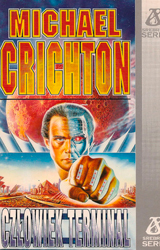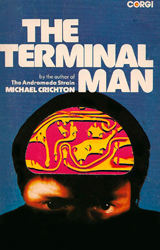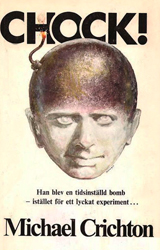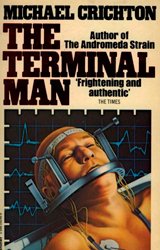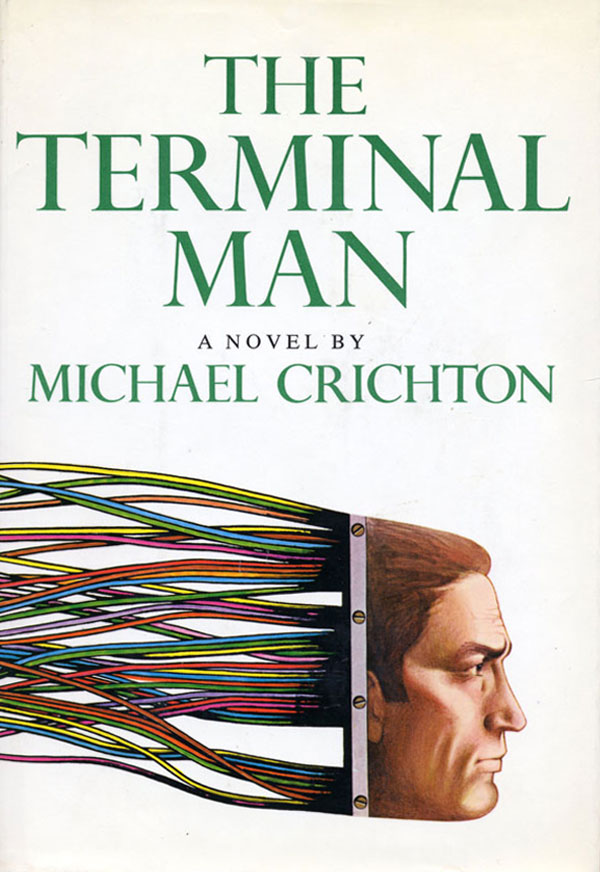The Terminal Man
In His Own Words
In the 1970s I saw a patient in a hospital who was being treated with electrodes implanted in the brain, hooked up to a monitoring computer. I thought this treatment was horrific, and I was amazed that the research seemed to be going forward with no public discussion or even knowledge. I decided to write a novel to make such procedures better known. This particular kind of surgery is no longer done much, so the journalistic aspects of the story are gone.


Synopsis
Harry Benson suffers from violent seizures. When he becomes part of an experimental program that sends electrodes to his brain to calm him, he is in recovery. Until he discovers how to get those soothing pulses more frequently, and then escapes the hopsital–on a murderous rampage with a deadly agenda …
Passage 1
She paused to get her breath and let the audience absorb what she had told them. “The patient is an intelligent man,” she said, “and his illness was explained to him. He was told he had injured his brain in the automobile accident and, as a result, had an illness that produced “thought seizures” – seizures of the mind, not the body, leading to loss of inhibitions and violent acts. He was told that the syndrome was well-studied and could be controlled. He was started on a series of drug trials.
“Three months ago, Benson was arrested on charges of assault and battery. The victim was a twenty-four-year-old topless dancer, who later dropped charges. The hospital intervened slightly on his behalf.
“One month ago, drug trials of morladone, para-amino benzadone, and triamiline were concluded. Benson showed no improvement on any drug or combination of drugs. He was therefore a stage two – drug-resistent ADL syndrome. And he was scheduled for a stage-three surgical procedure, which we will discuss today.”
She paused. “Before I bring him in,” she said, “I think I should add that yesterday afternoon he attacked a gas-station attendant and beat the man rather badly. His operation is scheduled for tomorrow and we have persuaded the police to release him in our custody. But he is still technically awaiting arraignment on charges of assault and battery.”
The room was silent as she turned, and went to bring in Benson.
Passage 2
“How are you feeling?” she asked, coming into the room. She sat on a chair beside the bed.
“Naked,” he said, and touched the towel. “It’s funny. You don’t realize how much hair you have until somebody cuts it all off.” He touched the towel again. “It must be worse for a woman.” Then he looked at her and became embarrassed.
“It’s not much fun for anybody,” she said.
“I guess not.” He lay back against the pillow. “After they did it, I looked in the wastebasket, and I was amazed. So much hair. And my head was cold. It was the funniest thing, a cold head. They put a towel around it. I said I wanted to look at my head – see what I looked like bald – but they said it wasn’t a good idea. So I waited until after they left, and then I got out of bed and went into the bathroom. But when I got there …”
“Yes?”
“I didn’t take the towel off.” He laughed. “I couldn’t do it. What does that mean?”
Passage 3
“He’s a very bright man,” Ross said. It was a fact that they all tended to forget. To the cops, Benson was a criminal charged with assault, one of the hundreds of querulous types they saw each day. To the hospital staff, he was a diseased man, unhappy, dangerous, borderline psychotic. Everyone tended to forget that Benson was also brilliant. His computer work was outstanding in a field where many intelligent men worked. In the initial psychological testing at the NPS, his abbreviated WAIS I.Q. test had scored 144. He was fully capable of planning to leave, then listening at the door, hearing the cop and the nurse discuss going for cigarettes – and then making his escape in a manner of minutes. But how?
Benson must have know that he could never get out of the hospital in his bathrobe. He had left his street clothes in his room – he probably couldn’t get out wearing those, either. Not at midnight. The lobby desk would have stopped him. Visiting hours had ended three hours before.
What the hell would he do?
From the Archives


In His Own Words
When people said ‘boy, this [The Andromeda Strain] is really up-to-date scientific information,’ I had to laugh. At best, the material was only about 30 years old and at worst, it was 70 years old. There’s a glossy technical surface that was new, but the basic kinds of information on mutants and bacteria and the plot line were a steal from War of the Worlds which was published in 1898. At that point I decided, ‘well if you think that this stuff is modern, how would you react to something that is really new?’ So I wrote The Terminal Man with the expectation that instead of being 30 to 70 years out of date, it would only be about 5 years out of date.
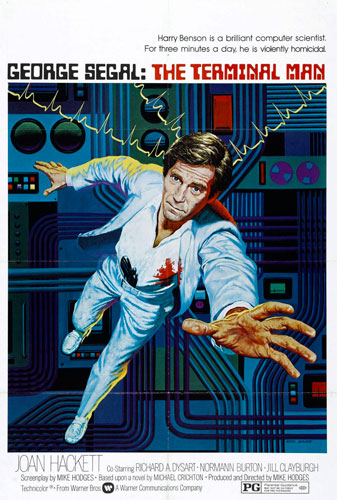

The Terminal Man (Movie)
| Release Date: | June 7, 1974 |
| Running Time: | 1 hr. 47 min. |
| MPAA: | PG |
| Director: | Mike Hodges |
| Screenwriter: | Mike Hodges |
| Based on the Novel By: | Michael Crichton |
| Studio: | Warner Bros. |
| Starring: | George Segal, Joan Hackett, Richard A. Dysartas, Donald Moffat, Jill Clayburgh, James Sikking |
Book Covers


















